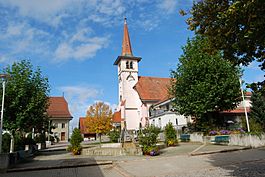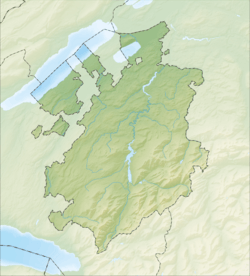Grolley facts for kids
Quick facts for kids
Grolley
|
||
|---|---|---|
 |
||
|
||
| Country | Switzerland | |
| Canton | Fribourg | |
| District | Sarine | |
| Area | ||
| • Total | 5.34 km2 (2.06 sq mi) | |
| Elevation | 625 m (2,051 ft) | |
| Population
(Dec 2020 )
|
||
| • Total | 2,084 | |
| • Density | 390.3/km2 (1,010.8/sq mi) | |
| Postal code |
1772
|
|
| Surrounded by | Autafond, Belfaux, Léchelles, Misery-Courtion, Ponthaux | |
Grolley is a municipality (which is like a small town or district) in the Sarine area of the Fribourg canton in Switzerland. It's a charming place with a rich history and a mix of nature and developed areas.
Contents
A Look at Grolley's History
Grolley was first mentioned a very long time ago, around the years 1137-1138. Back then, it was known as de Groslerio. This shows that people have lived and worked in this area for many centuries!
Geography and Land Use
Grolley covers an area of about 5.3 square kilometers (which is about 2 square miles). A big part of this land, almost 65%, is used for farming. This means there are lots of fields where crops grow and pastures where animals graze.
About 18% of Grolley is covered by forests, providing green spaces and homes for wildlife. The remaining 16.5% of the land is where buildings, roads, and other developed areas are located. This includes homes, businesses, and transportation routes.
Since the year 2000, Grolley has included two villages: Grolley itself and Corsalettes. The village of Corsalettes joined Grolley on January 1, 2000, making the municipality a bit larger.
Grolley's Coat of Arms
Every town has a special symbol called a coat of arms. Grolley's coat of arms has a unique design. It features a silver background with a gold top section. There are also black and green diagonal stripes, outlined in red. This new design was chosen after Corsalettes joined Grolley in 2000.
Who Lives in Grolley?
Grolley is home to about 1,800 people. Over the past ten years, the population has grown by about 9.5%. Most of this growth has been from people moving into Grolley.
Most people in Grolley, about 90%, speak French as their main language. German is the second most common language, spoken by about 6% of the population, followed by Italian.
In 2008, the population was almost evenly split between males and females. Many people living in Grolley were born there or in the same canton of Fribourg. About 10% of the residents were born outside of Switzerland.
Grolley has a good number of young people. About 29% of the population are children and teenagers (under 19 years old). Adults (aged 20-64) make up the largest group, and about 8.6% are seniors (over 64).
Grolley's Economy
In 2010, Grolley had a low unemployment rate, meaning most people who wanted jobs had them. The town has different types of jobs:
- Primary Sector: This includes jobs related to farming and agriculture. About 39 people worked in this area.
- Secondary Sector: These jobs involve making things, like in factories or construction. About 84 people worked in this sector.
- Tertiary Sector: This is the largest sector, with about 488 people working in services. This includes jobs in shops, restaurants, transportation, education, and healthcare.
Many people who live in Grolley travel to other towns for work. About 67% of the working population uses a private car to get to their jobs, while about 13% use public transportation like trains or buses.
Religion in Grolley
According to a census from 2000, most people in Grolley, about 83%, are Roman Catholic. About 7% belong to the Swiss Reformed Church. A small number of people belong to other Christian churches or are Islamic. About 5% of the population said they didn't belong to any church.
Education in Grolley
In Grolley, many people have completed a good level of education. About 36% of the population have finished upper secondary education, which is like high school. About 12% have gone on to higher education, like a university or a specialized college.
The school system in Fribourg canton works like this:
- Kindergarten: One year of optional kindergarten.
- Primary School: Six years of primary school.
- Lower Secondary School: Three years of required secondary school, where students are grouped by their abilities.
- Upper Secondary School: After lower secondary, students can choose to go to a three or four-year upper secondary school. This can be a gymnasium (which prepares students for university) or a vocational program (which teaches job skills).
- Tertiary School: After upper secondary, students can go to a university or continue their apprenticeship training.
During the 2010-2011 school year, Grolley had 202 students in 12 classes. There were 2 kindergarten classes and 7 primary classes. Students in lower secondary school traveled to a nearby municipality for their classes.
Getting Around: Transportation
Grolley has its own [[railway station, Grolley]]. This station is on the Fribourg–Yverdon line. This means residents can easily travel by train to nearby cities like Fribourg/Freiburg and Yverdon-les-Bains.
See also
 In Spanish: Grolley para niños
In Spanish: Grolley para niños




